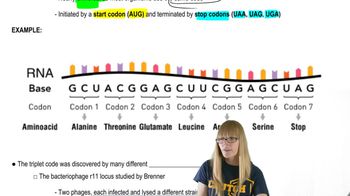Table of contents
- 1. Introduction to Genetics51m
- 2. Mendel's Laws of Inheritance3h 37m
- 3. Extensions to Mendelian Inheritance2h 41m
- 4. Genetic Mapping and Linkage2h 28m
- 5. Genetics of Bacteria and Viruses1h 21m
- 6. Chromosomal Variation1h 48m
- 7. DNA and Chromosome Structure56m
- 8. DNA Replication1h 10m
- 9. Mitosis and Meiosis1h 34m
- 10. Transcription1h 0m
- 11. Translation58m
- 12. Gene Regulation in Prokaryotes1h 19m
- 13. Gene Regulation in Eukaryotes44m
- 14. Genetic Control of Development44m
- 15. Genomes and Genomics1h 50m
- 16. Transposable Elements47m
- 17. Mutation, Repair, and Recombination1h 6m
- 18. Molecular Genetic Tools19m
- 19. Cancer Genetics29m
- 20. Quantitative Genetics1h 26m
- 21. Population Genetics50m
- 22. Evolutionary Genetics29m
17. Mutation, Repair, and Recombination
Types of Mutations
Problem 29
Textbook Question
Shown here are the amino acid sequences of the wild-type and three mutant forms of a short protein.
___________________________________________________
Wild-type: Met-Trp-Tyr-Arg-Gly-Ser-Pro-Thr
Mutant 1: Met-Trp
Mutant 2: Met-Trp-His-Arg-Gly-Ser-Pro-Thr
Mutant 3: Met-Cys-Ile-Val-Val-Val-Gln-His _
Use this information to answer the following questions:
Using the genetic coding dictionary, predict the type of mutation that led to each altered protein.
 Verified step by step guidance
Verified step by step guidance1
Identify the differences between the wild-type and each mutant sequence.
For Mutant 1, note that the sequence is truncated after 'Met-Trp'. This suggests a possible nonsense mutation, where a stop codon was introduced early.
For Mutant 2, observe that 'His' is inserted after 'Trp'. This could be due to a missense mutation where a single nucleotide change resulted in a different amino acid.
For Mutant 3, the entire sequence is different starting from the second amino acid. This suggests a frameshift mutation, likely due to an insertion or deletion, altering the reading frame.
Use the genetic code to verify the possible codon changes that could lead to these mutations.
Recommended similar problem, with video answer:
 Verified Solution
Verified SolutionThis video solution was recommended by our tutors as helpful for the problem above
Video duration:
1mPlay a video:
Was this helpful?
Key Concepts
Here are the essential concepts you must grasp in order to answer the question correctly.
Amino Acids and Protein Structure
Amino acids are the building blocks of proteins, and their specific sequence determines a protein's structure and function. Each amino acid is encoded by a set of three nucleotides in DNA, known as a codon. Changes in the amino acid sequence can lead to different protein properties, which is crucial for understanding mutations.
Recommended video:
Guided course

Proteins
Types of Mutations
Mutations are changes in the DNA sequence that can affect the resulting protein. Common types include point mutations (single nucleotide changes), insertions (adding nucleotides), and deletions (removing nucleotides). Each type can lead to different outcomes, such as silent mutations, missense mutations, or nonsense mutations, which can alter protein function.
Recommended video:
Guided course

Mutations and Phenotypes
Genetic Code and Codon Usage
The genetic code is a set of rules that defines how nucleotide sequences are translated into amino acids. Each codon corresponds to a specific amino acid or a stop signal. Understanding the genetic code is essential for predicting the effects of mutations on protein sequences, as it allows for the identification of which amino acids are affected by changes in the DNA.
Recommended video:
Guided course

The Genetic Code

 9:49m
9:49mWatch next
Master Point Mutations with a bite sized video explanation from Kylia Goodner
Start learning


